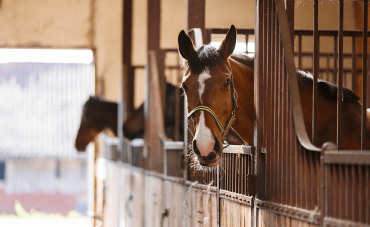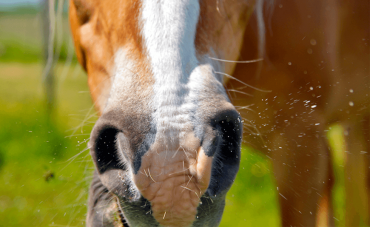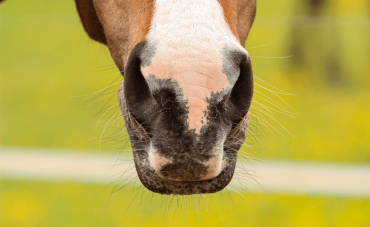On a day-to-day basis of taking care of your horse, you may ask yourself: how does my horse feel the pain and do I know when he does? This is a question that is not always easy to answer due to the complexity of communication, especially non-verbal communication with the horse. In this article, we to give you an overview of pain.
What is pain for horses?
It is difficult to define the notion of pain precisely. It is possible to use the definition of the IASP (International Association for the Study of Pain) scientists, who are the reference on the subject, and who define it as: "An unpleasant sensory and emotional experience associated with, or resembling that associated with, actual or potential tissue damage".
The complication with the horse is that it cannot verbally express its pain. However, this inability to communicate verbally does not mean that your horse cannot feel pain and require treatment by your vet.
We consider that there are two types of pain:
Acute pain
Short-lived (a few days), it is due to an injury or lesion and is "useful" as it is an alarm signal. The most common examples in horses are colic, foot abscesses, fractures, tendonitis...
Chronic pain
This type of pain lasts for a longer period of time (several weeks, months, years, etc.) and can be linked to the aggravation of the cause behind what was originally, acute pain or the consequences of the initial pain. It is this type of pain that must be prevented because it can lead to numerous disturbances: reduced appetite, slowed intestinal transit, disturbances in the heart and respiratory rhythm, reduced immunity, etc. The most common examples in horses are: chronic osteoarthritis, chronic laminitis, chronic uveitis or navicular syndrome.
While early management of pain can prevent it from getting worse, this does not mean that you should necessarily remove all sensation of pain. Let us explain. For instance, for a horse suffering from tendonitis, the objective will be to help the horse to relax and limit the inflammation but in no case to completely eliminate the pain which would make the horse lean "normally" on its leg and risk aggravating the lesions.
In order to manage the pain quickly and prevent it from getting worse, it is therefore important to recognise the signs in your horse.
How to recognise pain ?
As your horse is a prey, it is in its nature to hide the pain in regards to potential predators. In addition to this, as with humans, each horse will feel and express pain in different ways depending on many factors (personality, tolerance threshold, breed, etc.).
In order for you to be able to recognise the pain and try to measure its intensity (to judge the urgency of the situation and to be able to warn your vet accordingly for example), it will be important to try to be as objective as possible. For example, it is important to rely on objective criteria (lameness, swelling, etc.). Of course, it is also important to know your horse and his "normal" behaviour in order to be able to spot any changes.
To help you, here are some typical signs that can help you see if your horse is in pain:
- Change in appetite (no longer eating, not finishing meals, difficulty swallowing...).
- Behaviour with humans and other horses: You can also take a step back and see how your horse interacts with you or other horses. Again, this is to be correlated with your horse's 'normal' behaviour. For example, if your horse usually comes to you in the pasture and then stops coming, this may be a sign of pain.
- Behaviour in relation to his environment and surroundings: your horse will be uninterested in what is going on around him. He will not be intrigued by what is going on around him because he will be disturbed by his pain.
- Specific behaviours can be a sign of pain; this is the case for example of a horse that will start to roll a lot, to grind its teeth, to spend a lot of time lying down... This type of behaviour changes can also occur during work (regularity of the gaits, defences, drops in performance...).
- Facial expressions of pain. As with many animal species, the horse may show expressions that can indicate pain. Pay attention to its ears, nostrils, mouth and eyes.
- Changes in physiological parameters. Even if it is not always easy to measure them, it can be interesting to regularly check the constants of your horse: increase in the respiratory rate, increase in the heart rate, temperature...
More generally, not finding your horse in its normal state or with unusual behaviour can be a sign of pain.
In any case, if you feel that your horse may be showing signs of pain, we advise you to contact your veterinarian as soon as possible in order to find the causes of this pain so that they can be treated.
The consequences of pain in horses
As we discussed in the first part, although (acute) pain is initially an alarm signal allowing the body to react, it is important not to let it last too long, otherwise it will become chronic pain and have harmful consequences on the well-being of your horse. There are many consequences when pain is not properly managed:
- Infections: when pain is prolonged, it has been shown to cause stress to the horse. This stress will cause the production of a hormone, cortisol, which when circulated over a long period of time can affect your horse's immune system. A drop in your horse's immunity makes it more vulnerable to the many pathogens it may encounter in its environment (bacteria, viruses, etc.)
- Digestive disorders: changes in feeding behaviour (no longer eating or drinking) can have numerous consequences on your horse's digestive system, such as ulcers.
- Disturbances of the constants: the pain leads to an increase in the cardio respiratory function and therefore the energy requirements. This will result in fatigue or even exhaustion, which may lead to weight loss.
- Respiratory problems: if your horse's respiratory rate increases, this can lead to problems with lung infections or prevent the body from getting enough oxygen to keep your horse's body functioning properly.
To limit all these risks, it will be important, with the help of your veterinarian, to implement solutions to relieve your horse and if possible stop the pain (and its causes).
Managing pain in horses
As mentioned earlier, if your suspect your horse to be in pain, it is your vet who will be able to identify the specific cause(s) of the pain. Once your vet has been able to take a look at your horse and possibly carry out further tests, and has found the cause of the pain, he or she will be able to manage your horse's pain and provide appropriate treatment.
There are many different causes that can lead to pain in your horse and treatments will be tailored to each of them.
In terms of medication management, your vet has a wide range of products available to help relieve your horse's pain:
- Non-steroidal anti-inflammatories: as the name suggests, these will help to limit inflammation and therefore often pain. There are several types of anti-inflammatory drugs which have a more or less targeted action. Selective Cox 1s, such as flunixin and penylbutazone, will have an action on pain but will also have an action on physiological mechanisms such as stomach protection, hence a potential risk of side effects. Preferential Cox-2s, such as meloxicam, will have an action on pain and a very moderate negative action on physiological mechanisms. Selective Cox-2s, such as firocoxib, will have a targeted action on pain and a very weak negative action on physiological mechanisms. They are used for all types of pain: digestive, orthopaedic, ocular, etc. Non-steroidal anti-inflammatory drugs exist in several forms: injection by the veterinarian, oral treatment in the form of powder to be mixed with food, liquid to be swallowed or tablets to be given by hand.
- Steroidal anti-inflammatories: this category includes corticoids. They have an action on pain, inflammation but also on allergic reactions and are very effective on oedemas. They are mainly used for pain with allergic components, such as in asthma (emphysema) and recurrent summer dermatitis, but also to relieve arthritic horses by infiltration. They can be administered in different forms: in injection, infiltration, in oral form such as powder or tablets or as a gel to be applied locally to the painful area. Read our full article on anti-inflammatories.
- Morphinics: morphine derivatives can also be used to treat pain. This can be morphine or one of its derivatives: butorphanol. These molecules act directly on pain receptors. They only exist in injectable form in horses and are used to treat acute pain, particularly in hospitalised horses.
- Sedatives: some products used by your vet to tranquillise your horse for certain examinations or minor surgical procedures will also have a pain-relieving effect in addition to the tranquillising effect. This is the case of sedomidine and detomidine. These two products are mainly used as injections.
- Biphosphonates: they are not directly painkillers but they will have an effect on pain. Their action on the subchondral bone of the joints makes it possible to stop the bone remodelling mechanism during osteoarthritis. This mechanism, which leads to the destruction of the bone (osteolysis), is painful. Stopping this mechanism therefore makes it possible to relieve the associated pain. There are 2 molecules in this family: tiludronate and clodronate.
- Local anaesthetics: as their name indicates, they are products that have a local anaesthetic effect. The product acts locally on the nerves by preventing the nervous message of pain from circulating. Thus the horse does not feel the pain locally. The most commonly used local anaesthetic is lidocaine. It can be used as a gel to be applied locally or as an injection to be given under the skin.
Pain can take many forms in your horse. Its expression varies according to its origin but also to the tolerance of your horse. For some horses, a simple change of behaviour can be a sign of pain. Rapid treatment by your veterinarian can avoid the risk of deterioration during acute pain but also prevent the pain from becoming chronic.
I's important to remember that pain is not normal and it must be treated to avoid disturbances to its well-being. As always, if you have any doubts, contact your veterinarian
If you have any questions, don't hesitate to ask us on our social media.










